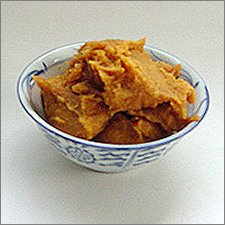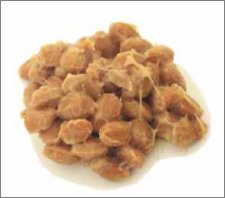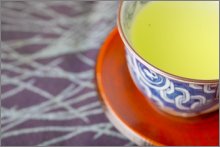The 6 Healthiest Staple Foods in Japanese Cuisine
by www.SixWise.com
Japanese cuisine relies heavily on the surrounding ocean -- seafood including
fish, octopus, squid, crab, clams, shrimp, lobster and seaweed is a staple part
of many meals.
Even more standard than seafood, though, is steamed white rice, which is eaten
with just about every meal. Beef, noodles and spices like ginger, soy sauce,
wasabi (Japanese horseradish), rice wine and rice vinegar are other essential
ingredients.
Japanese food is often regarded as one of the healthiest cuisines in the world,
but here we've highlighted the best of the best when it comes to traditional
Japanese cooking. And don't miss the recipes below to try some of these tasty
foods tonight.
 1.
Miso
1.
Miso
Miso is a fermented soybean paste. After fermenting for a number of weeks to
years, depending on variety, miso comes out with a texture similar to peanut
butter, and a strong, salty flavor. It is used as a condiment, a flavoring agent
and to make the popular miso soup.
Health Benefits: Miso contains many trace minerals including zinc, manganese,
and copper, which help to strengthen the immune system, boost energy, and protect
bones and blood vessels. It is also a rich source of protein -- one tablespoon
has 2 grams of protein and just 25 calories.
Studies have also found that substances in miso help reduce the risk of breast
cancer. Note: Miso is high in sodium, so it may not be appropriate for those
on low-sodium diets.
 2.
Seaweed
2.
Seaweed
Seaweeds like kelp, wakame, arame and dulse are commonly used to make Japanese
salads and are added to soups, stews and other dishes. Seaweed is also used
as a wrap for sushi. Seaweed tastes similar to leafy green vegetables, with
an underlying salty, sea flavor.
Health Benefits: Seaweed contains the broadest range of minerals of
any food -- the same minerals found in the ocean and in human blood, such as
potassium, calcium, magnesium, iron, and iodine.
Seaweed also contains vitamin C, fiber, beta-carotene, and pantothenic acid
and riboflavin -- two B-vitamins needed for your body to produce energy.
 3.
Natto
3.
Natto
Natto is made from fermented soybeans and is a common breakfast food in Japan.
It has a strong smell -- somewhat like a strong cheese -- and a sticky texture,
and is often eaten with rice, soy sauce and chopped green onion.
Health Benefits: Natto is an excellent source of protein, vitamin B2,
and vitamin k2, which is useful for preventing osteoporosis. It contains compounds
including phytoestrogen,
selenium
and others that may help prevent cancer, and also contains a powerful beneficial
enzyme called nattokinase.
Nattokinase has been found to help prevent and reduce the risk of blood clots,
as well as provide heart-protective benefits. Some studies suggest that nattokinase
can also reduce the risk of heart attack and stroke.
NOTE: For an excellent natto-based supplement be sure to check out CardioEssentials.
 4.
Mushrooms
4.
Mushrooms
Many mushroom
varieties, including shitake and enoki, are popular in Japanese cuisine.
They're used in soups, salads, and many other dishes.
Health Benefits: Mushrooms are rich in protein, fiber, vitamin C, B
vitamins, calcium and minerals, but they are also renowned for their many medicinal
properties. These nutritional powerhouses have been found to:
- Protect heart health
- Lower the risk of cancer
- Boost immune function
- Reduce high cholesterol
- Fight off viruses, bacteria and fungi
- Reduce inflammation
- Combat allergies
- Help balance blood sugar levels
- Support the body's detoxification mechanisms
- Help fight blood clots
 5.
Green Tea
5.
Green Tea
Green tea is served at the end of traditional Japanese meals (not throughout
the meal as is common in the United States). Although widely consumed in Japan
for centuries, green tea is thought to have originated in China and Northern
India.
Health Benefits: Green tea is a rich source of catechin polyphenols,
namely epigallocatechin gallate (EGCG), which is a potent antioxidant that appears
to be responsible for many of green tea's health benefits. Green tea has been
found to help:
- Cancer
- Rheumatoid arthritis
- High cholesterol levels
- Heart disease
- Infection
- Impaired immune function
- Obesity, overweight
- High blood sugar levels
Note: Certain varieties of green tea (and other tea) may contain excessive
levels of fluoride that could be harmful. Before drinking green tea, it's
important to find a source that is pure.
 6.
Sashimi
6.
Sashimi
Sashimi is thinly sliced raw fish, savored for its simplicity and often served
with wasabi and soy sauce, and sometimes a bowl of rice.
Health Benefits: Sashimi offers all of the benefits of fresh fish -- an excellent
source of protein, omega-3 fats, and other nutrients like selenium, niacin and
vitamin B12, phosphorous, magnesium and vitamin B6. Because sashimi is consumed
raw, it is possible for it to contain parasites, but choosing "sashimi
grade" fish, or dining at a reputable restaurant, should reduce these risks.
Tasty and Healthy Japanese Dishes
Miso Soup with Tofu
Makes 4 servings
Ingredients:
- 4 cups dashi soup stock (see below)
- 1/2 cup tofu
- 3 tbsp miso paste
- 1/4 cup chopped green onion
Preparation:
- Put dashi soup stock in a pan and bring to a boil.
- Cut tofu into small cubes and add them to the soup.
- Scoop out some soup stock from the pan and dissolve miso paste in it.
- Return the soup in the pan.
- Stop the heat and add chopped green onion.
- Remember not to boil the soup after you put miso in.
Dashi Soup Stock
Ingredients:
- 4 cups of water
- 6 inches long konbu (Dried kelp)
Preparation:
- Wipe the konbu with clean cloth to remove dirt. (Konbu shouldn't be washed.)
- Soak the konbu in the water in a pot for one to two hours.
- Put on low heat and bring the water to boil.
- Just before the water comes to a boil, remove the konbu.
Source: Setsuko
Yoshizuka, Your Guide to Japanese Cuisine
Cucumber and Wakame Seaweed Salad
Ingredients:
- 1 cucumber
- 1/4 lb. wakame seaweed
- 4 tbsp rice wine vinegar
- 1 tbsp sugar
- 3 tbsp soy sauce
- 1/2 tsp salt
Preparation:
- Soak wakame seaweed in water until softened.
- Cut cucumber into thin rounds.
- Put salt over cucumber slices and set aside for 30 min.
- Squeeze cucumber slices to remove the liquid.
- Mix vinegar, sugar, and soy sauce in a cup.
- Cut wakame seaweed into bite-sized pieces.
- Put wakame seaweed and cucumber in a bowl, pour the dressing over and mix
well.
Source: Setsuko
Yoshizuka, Your Guide to Japanese Cuisine
Recommended Reading
The
6 Healthiest Staple Foods in Italian Cuisine
The
6 Healthiest Staple Foods in Greek Cuisine
Sources
The World's Healthiest Foods
WholeHealth
MD